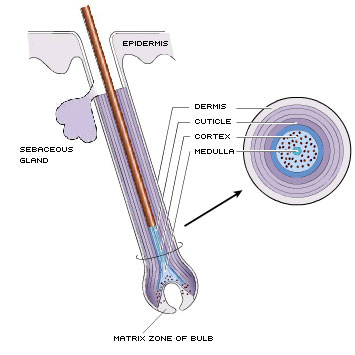The structure and chemical composition of hair provides information about the interactions between drugs1 that enter the hair follicle2 and the hair itself. Hair consists of mostly fibrous protein (65-95 %). In addition, it contains a small amount of lipids and water. Hair is made in sac-like structures, called follicles. The follicles are rather simple organs that go through growth and rest phases. They are made of epithelial cells3, continuous with the surface epidermis (outermost skin layer) (Figure 4). Follicles grow down into the dermis layer and below, forming a canal that holds the hair shaft. Groups of cells in the follicle form a sheath around the hair to help it grow within the canal.
Figure 4 Detailed view of a hair follicle. A cross section of the hair shaft shows the 3 layers of cells. The small dark spots in the cortical cell layer are the melanin granules.
Sebaceous glands are connected to most follicles near the skin surface. At the bottom of the follicle there is a bulb containing a bundle of cells. These cells are part of a matrix and they are responsible for making the hair. They require a lot of nutrients because they are constantly going through mitosis to keep up with their synthetic demands. The cells in the matrix include the keratinocytes4 (“cytes” = cells), which make keratin. Keratin is a fibrous protein that contains many sulphur bonds, which help to give the hair strength and structure. [During a “perm”, the sulphur bonds are broken and reformed to provide the curl.] There are also special cells called melanocytes5 that make melanin6, or hair pigment. Higher up in the bulb, the hair attains a more organized form, consisting of 3 layers of cells. The outermost layer is the cuticle, which is very scaly (easily viewed with a microscope). The cuticle cells help anchor the hair in the follicle and protect the middle layer of cells called the cortex. The cortex forms the major part of the hair and it contains keratinocytes and melanocytes. Higher up the follicle, the keratinocytes become keratinized; that is, they finish making keratin and then they die. The innermost layer is called the medulla. There are large keratinized cells in the medullary layer, along with many air pockets. These air pockets help to determine the sheen and color tones of hair by influencing the reflection of light.
Definitions:
1 a substance that affects the structure or function of a cell or organism.
2 a small sac; hair follicles are internalized structures of epithelial cells in which the hair is synthesized and grows
3 cells that line all free surfaces such as the skin, nasal passages and the gut
4 the cells in which keratin is synthesized within the follicle
5 the cells in the hair matrix and in the cortex that synthesize melanin.
6 the pigment found in hair, skin, feathers, etc.. It is a biopolymer found in granules within melanocytes and transferred to keratinocytes to provide hair color.

